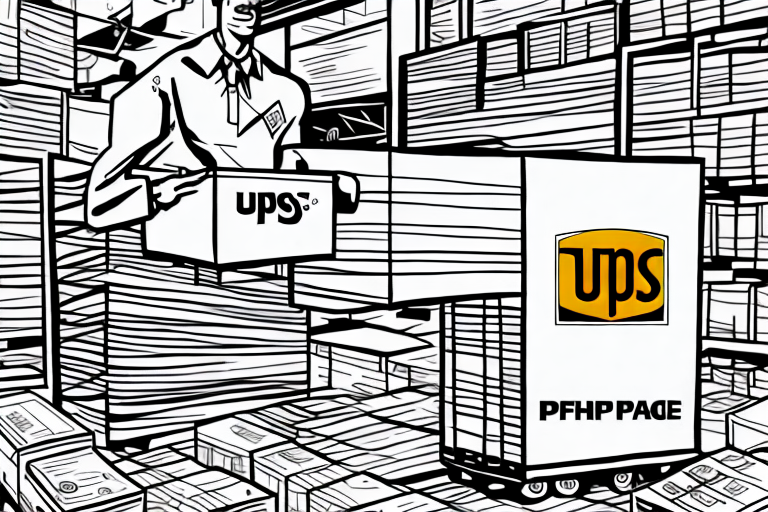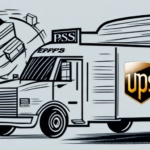Streamline Your UPS Returns WW Standard Process: A Comprehensive Guide
Managing product returns is a critical aspect of any global e-commerce business. According to a Statista report, the average return rate for online retailers stands at approximately 20-30%. A reliable returns process not only enhances customer satisfaction but also reduces operational costs. With UPS Returns WW Standard, businesses can offer worldwide customers a seamless and cost-effective way to return merchandise. However, navigating the UPS returns process can present challenges. This guide offers valuable tips to streamline your UPS Returns WW Standard process, ensuring efficiency and customer satisfaction.
A Step-by-Step Guide to Streamline Your UPS Returns WW Standard Process
Having a clear understanding of the UPS Returns WW Standard process is essential for efficient return management. Follow this step-by-step guide to ensure that every return is handled accurately and promptly:
- Customer Initiates Return: The customer submits a return request through your website or customer service portal and receives a return label from your business.
- Customer Ships Back the Product: The customer affixes the return label to the package and ships it back to your designated UPS facility.
- Receive and Inspect Returns: Your business receives the returned merchandise and assesses whether the item will be refunded or exchanged.
- Process Refund or Exchange: Your business processes the refund or exchange, updating the customer's account accordingly.
Following these steps ensures a smooth UPS Returns WW Standard process. Additionally, consider the following aspects to further enhance your returns management:
Effective Communication: Maintain clear and consistent communication with customers throughout the return process. Inform them when their package is received and when their refund or exchange is processed. This transparency builds trust and encourages repeat business.
Tips to Simplify the UPS Returns WW Standard Process for Your Business
Simplifying the returns process not only improves customer experience but also optimizes your operational efficiency. Here are several strategies to make the UPS Returns WW Standard process more straightforward:
Provide Clear Return Instructions
Ensure that your return instructions are concise and easy to follow. Clear guidelines on how to package items, where to affix the return label, and any other specific requirements reduce the likelihood of errors and delays.
Offer Multiple Return Options
Provide customers with various return methods, such as dropping off at designated UPS locations or scheduling a pickup from their address. Offering flexibility increases the convenience for customers, thereby enhancing their satisfaction.
Automate the Return Process
Implementing automated software solutions can significantly streamline your returns process. Look for platforms that allow customers to generate return labels autonomously and automatically update your inventory once returns are received. Tools like ShipScience's automated returns management can facilitate this integration.
Provide Timely Refunds
Ensure that refunds are processed promptly. Clearly communicate your refund policies to customers, including the expected timeframe for receiving their money or exchange. Quick refunds enhance customer trust and loyalty.
Track Your Returns
Utilize a robust tracking system to monitor the status of returns at every stage. This not only helps in identifying any bottlenecks but also allows you to provide accurate updates to customers, thereby improving their overall experience.
Maximize Efficiency: How to Optimize Your UPS Returns WW Standard Process
Optimizing your UPS Returns WW Standard process involves leveraging technology, forecasting returns, and utilizing data analytics to identify improvement areas. Here’s how to optimize effectively:
Use Technology to Your Advantage
Invest in returns management software that can automate and streamline your processes. Integration with your existing e-commerce platform ensures seamless data flow, reducing manual effort and minimizing errors.
Forecast Future Returns
Leverage analytics tools to predict return trends based on historical data. Accurate forecasting enables you to allocate resources effectively, preventing stock-outs and ensuring that your operations team is prepared to handle returns efficiently.
Analyze Return Data and Improve
Regularly analyze return data to identify patterns and underlying issues. Understanding why customers return products—such as sizing issues or product defects—can help you address these problems proactively, reducing the overall return rate.
Implement a Clear Returns Policy
A transparent and well-communicated returns policy can reduce confusion and prevent unnecessary returns. Ensure that your policy is easily accessible on your website and outlines the steps for initiating a return, the allowable timeframe, and any associated fees or restrictions.
Understanding the UPS Returns WW Standard Process: A Comprehensive Overview
To effectively manage your UPS Returns WW Standard process, it's essential to have a comprehensive understanding of its components. Here's an in-depth look at each element:
Initiating a Return Request
Customers can initiate return requests through your website or by contacting your customer service team. Provide them with a return label and detailed instructions to ensure the process is straightforward.
Shipping the Return
Give customers multiple shipping options, including UPS, USPS, and FedEx. Clearly state which carriers are supported and provide appropriate return labels for each. This flexibility can enhance customer satisfaction.
Returning the Merchandise
Your business must decide whether to handle returned merchandise in-house or outsource it to a third-party logistics provider (3PL). Outsourcing can often lead to greater efficiency and accuracy in handling returns.
Processing the Return
Once the returned item is received, assess its condition and decide whether to issue a refund or provide an exchange. Update the customer's account immediately to reflect the return status, ensuring transparency.
Tracking the Return
Use the tracking number provided by the shipping carrier to monitor the return package's journey. This tracking helps in managing inventory and provides customers with real-time updates on their return status.
Improving the Returns Process
Regularly review return reasons and process efficiency. For example, if a significant number of returns are due to sizing issues, consider enhancing your product descriptions or sizing charts to mitigate this problem.
Common Challenges Faced in the UPS Returns WW Standard Process and How to Overcome Them
Despite its benefits, managing the UPS Returns WW Standard process can present several challenges. Here are some common issues and strategies to address them:
Shipping Costs
Offering returns is essential for customer satisfaction, but it incurs costs. To mitigate these expenses, consider providing customers with discounts on future purchases as an incentive for returning products or absorbing some of the return shipping costs in your pricing strategy.
Incorrect Return Labels
Errors in return labels can lead to lost shipments and delays. Ensure that return labels are clear, correctly formatted, and easily affixed to packages. Implement double-check systems or automated label generation to minimize mistakes.
Tracking Returns
Effectively tracking a high volume of returns can be daunting. Employ advanced returns management software that provides real-time tracking and centralized management, ensuring that each return is accounted for and processed swiftly.
Best Practices to Enhance Your Experience with the UPS Returns WW Standard Process
Adhering to best practices in managing returns can significantly improve your efficiency and customer satisfaction:
Make Returns Easy for Customers
Design an intuitive returns process with clear instructions and multiple return options. The easier it is for customers to return products, the more likely they are to shop with you again.
Use Automated Software
Implement automated returns management software that integrates seamlessly with your e-commerce platform. Automation reduces manual errors, speeds up processing times, and provides valuable insights into return trends.
Respond to Customers Quickly
Promptly address customer inquiries and concerns related to returns. Efficient customer service during the returns process fosters loyalty and encourages repeat business.
Navigating the UPS Returns WW Standard Process: Dos and Don'ts for Success
To effectively navigate the UPS Returns WW Standard process, consider the following dos and don'ts:
Do Provide Clear Return Instructions
Ensure that return instructions are precise and easy to follow. Clear guidelines prevent confusion and reduce the likelihood of errors in the returns process.
Don't Charge Customers Hidden Fees
Maintain transparency by avoiding hidden fees in your returns policy. Clearly communicate any costs associated with returns upfront, fostering trust and credibility with your customers.
Do Leverage Technology to Streamline the Process
Utilize technology to automate and refine your returns processes. Technology integration can lead to significant time and cost savings while enhancing accuracy and efficiency.
How Technology Can Help You Simplify the UPS Returns WW Standard Process
Technology plays a pivotal role in simplifying and optimizing your returns process. Here’s how leveraging the right tools can make a difference:
Integrations with Ecommerce Platforms
Use software that integrates seamlessly with your existing ecommerce platforms, enabling automated data synchronization, reducing manual data entry, and ensuring high accuracy in managing returns.
Automated Refunds and Exchanges
Automate the refund and exchange process to speed up customer reimbursements and inventory updates. Automation minimizes human errors and ensures timely processing, enhancing the customer experience.
Real-Time Analytics
Implement real-time analytics to gain insights into return patterns and operational performance. Data-driven decisions help in identifying improvement opportunities and optimizing the returns process effectively.
Cost-Effective Solutions to Streamline Your UPS Returns WW Standard Process
Streamlining the returns process can reduce costs and improve efficiency. Here are some cost-effective solutions to consider:
Outsource Returns Processing
Outsourcing returns processing to a third-party logistics provider (3PL) can save time and reduce operational costs. A 3PL can handle returns with higher efficiency and accuracy, allowing you to focus on core business activities.
Offer Discounted Return Shipping
Provide customers with discounted return shipping rates as an incentive for using your returns process. This approach can increase return usage while managing shipping costs effectively.
Implement an Automated Returns Platform
Adopt an automated returns platform that handles the entire returns workflow, from label generation to inventory updates. Automation enhances accuracy, speeds up processing, and improves the overall customer experience.
Conclusion
Managing the UPS Returns WW Standard process doesn't have to be daunting. By understanding each component, leveraging technology, and adhering to best practices, you can streamline your returns process effectively. This not only enhances customer satisfaction but also reduces operational costs, allowing your business to thrive in a competitive global marketplace. Implement the strategies outlined in this guide to offer hassle-free returns to your customers worldwide while maximizing efficiency and minimizing costs.






















